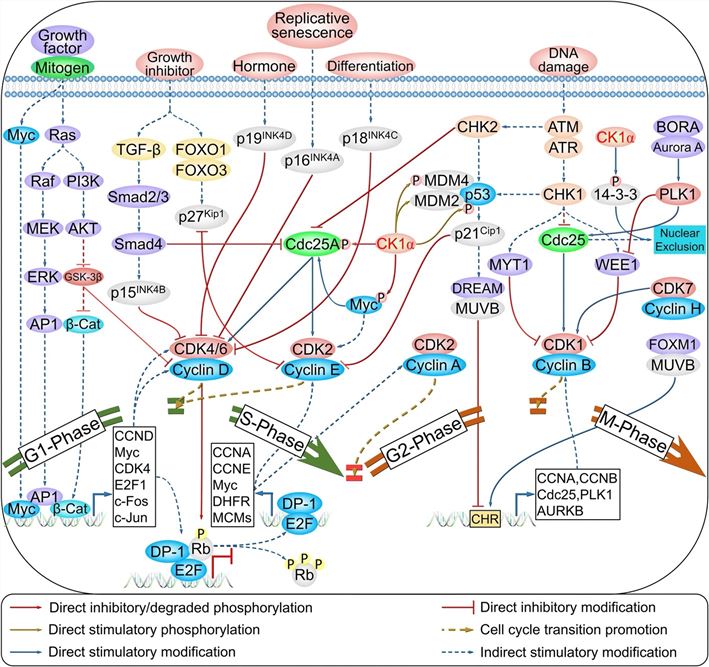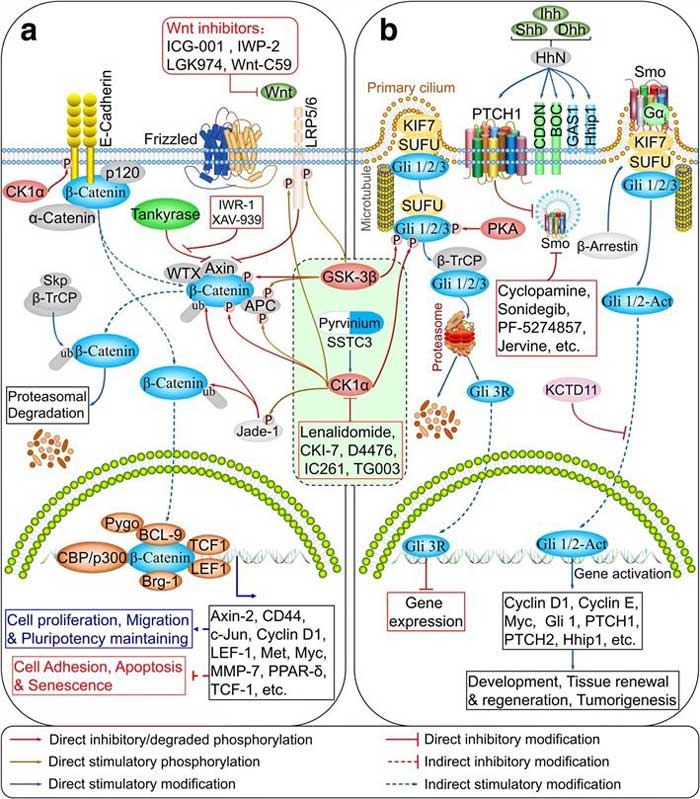Casein Kinases
Related Symbol Search List
Immunology Background
About Casein Kinases
Casein kinases are a family of protein kinases that phosphorylate serine and threonine residues in target proteins. They are classified into two main subfamilies, namely casein kinase 1 (CK1) and casein kinase 2 (CK2). CK1 family members include CK1α, CK1β, CK1δ, and CK1ε, while CK2 is composed of CK2α and CK2β subunits. Casein kinases are ubiquitously expressed in various tissues and are involved in diverse cellular processes.
Casein kinases are a family of serine/threonine protein kinases that play important roles in cellular signaling and regulation. These kinases are named after their ability to phosphorylate casein, a milk protein, but they have a much wider range of substrates in cells. Casein kinases are involved in various cellular processes, including cell cycle regulation, transcriptional control, and cellular differentiation.
Mechanism of Action of Casein Kinases
Casein kinases exert their effects through the phosphorylation of specific serine and threonine residues on target proteins. Casein kinases have constitutive activity and can phosphorylate their substrates in a basal state. This phosphorylation can modulate the activity, localization, stability, or protein-protein interactions of the target proteins. The diverse roles of casein kinases are achieved through their interactions with a wide array of substrates, including transcription factors, signaling molecules, and structural proteins. Moreover, casein kinases are involved in intricate signaling networks, where they exert regulatory control over key cellular processes. Their activity is precisely regulated through phosphorylation, subcellular localization, and interactions with regulatory subunits.
Functions of Casein Kinases
Casein kinases are involved in a wide range of cellular processes and signaling pathways. Here are some examples of their functions:
- Cell Cycle Regulation
Casein kinases play important roles in cell cycle progression and checkpoint control. They phosphorylate key cell cycle regulators, such as cyclins, cyclin-dependent kinases (CDKs), and tumor suppressor proteins. By modulating the activity and stability of these proteins, casein kinases contribute to the regulation of cell cycle transitions, DNA replication, and cell division.
 Fig.1 Cell cycle regulation by CK1α. (Jiang S, et al., 2018)
Fig.1 Cell cycle regulation by CK1α. (Jiang S, et al., 2018)
- Transcriptional Control
Casein kinases participate in the regulation of gene expression by phosphorylating transcription factors and co-regulators. They can modulate the activity and stability of these proteins, influencing their DNA binding, transcriptional activation or repression, and protein-protein interactions. Casein kinases are involved in diverse transcriptional processes, including developmental gene regulation, circadian rhythm control, and response to cellular stress.
- Cellular Signaling and Signal Transduction
Casein kinases are key players in various signaling pathways. They phosphorylate components of signaling cascades, such as kinases, phosphatases, and scaffold proteins, thereby regulating their activity and localization. Casein kinases are involved in the Wnt, Hedgehog, and Notch signaling pathways, which play crucial roles in development, cell fate determination, and tissue homeostasis.
 Fig.2 CK1α mediates crosstalk between Wnt/β-catenin and Hedgehog signaling networks. a, b CK1α in Wnt/β-catenin (a) and Hedgehog (b) signaling pathways. (Jiang S, et al., 2018)
Fig.2 CK1α mediates crosstalk between Wnt/β-catenin and Hedgehog signaling networks. a, b CK1α in Wnt/β-catenin (a) and Hedgehog (b) signaling pathways. (Jiang S, et al., 2018)
- Cellular Differentiation and Development
Casein kinases contribute to cellular differentiation and development processes. They phosphorylate proteins involved in cell fate determination, stem cell maintenance, and tissue-specific differentiation. Casein kinases also participate in the regulation of morphogenesis, embryonic development, and tissue regeneration.
Available Resources for Casein Kinases
Understanding the specific functions and regulation of casein kinases is crucial for unraveling the complexities of cellular signaling pathways and their implications in various cellular processes. At Creative BioMart, we offer a comprehensive range of research tools and services to support studies related to casein kinases, including recombinant proteins, cell & tissue lysates, protein pre-coupled magnetic beads, and custom assay development. The following casein kinases are displayed, click to view all related molecules/targets and research reagents. Please feel free to contact us with any questions or requests.
References:
- Jiang S, Zhang M, Sun J, et al. Casein kinase 1α: biological mechanisms and theranostic potential[J]. Cell Communication and Signaling, 2018, 16: 1-24.
- Francisco JC, Virshup DM. Casein Kinase 1 and Human Disease: Insights From the Circadian Phosphoswitch. Front Mol Biosci. 2022;9:911764. Published 2022 Jun 3. doi:10.3389/fmolb.2022.911764

